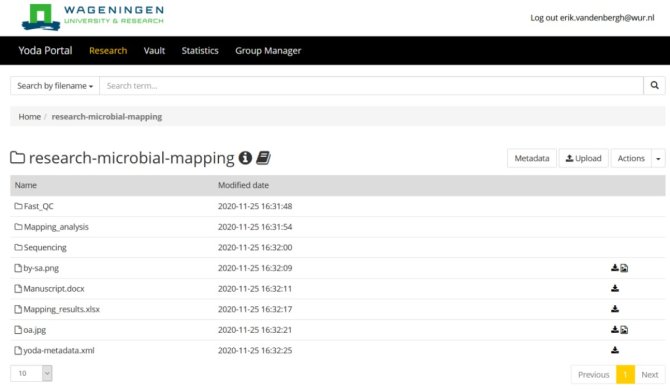
News
New WUR data storage: goodbye flash drive
The terms iRODS and Yoda may sound more like figures in a Star Wars movie than useful software researchers can use to store data. The Wageningen Data Competence Centre (WDCC) is rolling out the system throughout WUR over the next few months. Infrastructure coordinator Erik van den Bergh: ‘All it takes to store results, share them with others and make them available for future researchers, is a few mouse clicks.’
Over the past months, the WDCC ran several successful pilots with the software, says Erik van den Bergh, WDCC infrastructure coordinator since 2017. ‘iRODS (integrated Rule Oriented Data System) was developed in the United States by universities to create a uniform method of filing and sharing data. But, as the programme seemed rather complicated, Utrecht University developed the expansion Yoda (Your Data). This allows researchers to store their data in a simple filing structure similar to that on the W-disk or Dropbox.’
Results are stored in folders, similar to those you use on your W-drive or Dropbox.

Advantages of central storage: trustworthy and accessible
‘These new storage systems are a lot safer than the still frequently used flash drives, external hard disks or Google and Dropbox cloud storage.’ Those devices and login codes often disappear along with the researcher when he or she takes a position elsewhere or retires, says Van den Bergh. ‘A summary of the research data is provided in publications, but the raw data is often unavailable or difficult to locate.’ And it is precisely this raw data scientists need if they wish to replicate a study at a later time, which is often done to support the conclusions. ‘You would also require the metadata: information on equipment and research conditions etc. Now, researchers have to enter this information repeatedly in text documents with all their partial results. In Yoda, you only have to do this once.’
This new storage system meets the NWO (Dutch Research Council) requirements.
Centralised and safe
All data is stored on the WUR or SURF servers using the new software. SURF is a national IT platform for science. ‘We are working in stages, but I feel confident in saying we already have more than sufficient space to store all of WUR’s research data, and we are still adding more room.’ Storing everything in one place: how safe is that? ‘Very safe. We have back-ups and back-ups of the back-ups. Moreover, the systems have been secured in such a way they are safe for storing personal data such as surveys and business information’, says coordinator Van den Bergh. ‘In any event, it is much safer than Google or Dropbox cloud storage, or a flash drive you may easily misplace.’
FAIR = meeting the (international) standards
Wageningen researchers benefit from using Yoda in their work. Moreover, in doing so, they meet the international standards, Van den Bergh stresses. ‘The G20 declared in 2016 that all research data storage should meet the FAIR principle: Findable, Accessible, Interoperable and Reusable. The Dutch Research Council (Dutch acronym NWO) demands researchers meet the FAIR standards in their research if they wish to be considered for funding. By deploying iRODS and Yoda, WUR is pioneering in this regard.’
Proper data management can save the researcher a lot of work.
Data management unburdens the researcher
After watching a simple PowerPoint presentation, every researcher can use the software. But data management offers many more possibilities, the WDGG coordinator explains enthusiastically. ‘I understand that the whole computer issue is not a top priority for many researchers. But we can consult with researchers to see how WDCC can help. Sometimes, other groups at the university have already developed software that is useful for you.’ And, it can even save a lot of labour or elevate the research to a higher level. Consider, for example, the possibility of analysing thousands of satellite images at once.
Read the entire interview with Erik van den Berg on the possibilities of data.